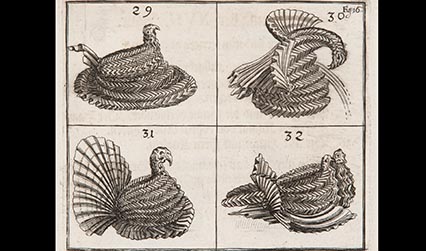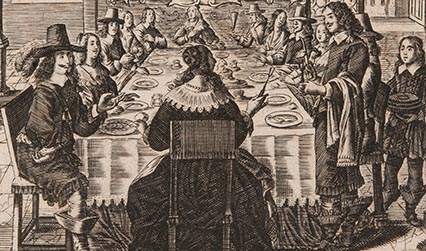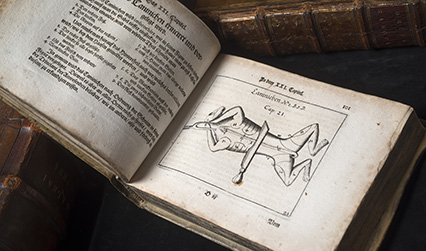Despite what you might imagine, it’s not all anatomy textbooks and pharmacological handbooks in the RCP library. Over 500 years, RCP fellows have had extraordinarily wide interests, spanning science, literature, art, culture and even cuisine.
Food is the subject of this month’s curator’s curiosity, on display until 15 May 2018.
This book caught my eye by chance several years ago. I was looking along the shelves in the Dorchester Library for something else, but the unusual shape of this book – wider than it is tall – enticed me to take a closer look at it.
It’s the pictures inside that make this book memorable. Dozens of diagrams demonstrate how to carve all kinds of roast meat: rabbits, calves’ heads, turkeys, ducks, geese, fish and even lobsters. Most of these are oblong in shape – wider than they are tall – which is why the book was printed in this unusual shape.

As well as the carving how-to diagrams (in which each cut is carefully labelled), there are delicate engravings showing how to fold napkins into elaborate, and frankly unbelievable, sculptures such as a pair of turtle doves or a pelican. A subsequent section shows ways in which to carve apples and pears into intricate table decorations and centrepieces.
The text tells you everything you need to know about fine dining in the 17th century. It covers how to decorate the table, how to serve and carve dishes, seasonal specialities throughout the year, banqueting, and questions of etiquette.

Though the text is in German, the title page of the book explains that the contents will instruct the reader in the most elegant Italian court style. Books with illustrations similar to these were published for over 100 years, becoming increasingly complicated over time. The earliest versions came from Italy, and spread across the continent, being translated into many different European languages. The title of this version translates as the ‘Complete and newly revised carving book’, but many of the images were directly copied or reused from earlier editions.

We don’t know who owned this book before it entered our library, but it was likely to have been an RCP fellow. Banquets were a key part of life for physicians in the 17th century. Traditionally it was the custom for a new fellow to foot the bill for a celebratory banquet held to welcome them into the RCP. The RCP museum collection contains many items of silverware intended for use at these banquets, but history does record whether the table-lining was folded as elaborately as specified in the Trincir-Buch.
Katie Birkwood, rare books and special collections librarian
In celebration of our anniversary year, the RCP Museum team has developed a new heritage trail called Curator’s Curiosities to share with the public some of the more curious stories behind our special collections. Alongside special purple signs around our Regent’s Park building, we are featuring monthly rotating displays of treasures from our stores which are rarely exhibited.
Visit the RCP and see the Trincir-Buch displayed in the Treasures Room until 15 May 2018.
